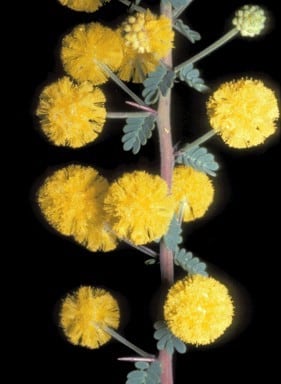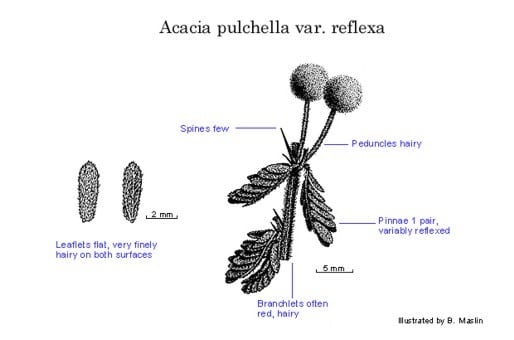Acacia pulchella var. reflexa Maslin
WATTLE
Acacias of Australia
Family
Fabaceae
Distribution
Occurs from Badgingarra–Coorow S to Bullsbrook East and near York, W.A.
Description
Branchlets often red, pubescent to puberulous. Axillary spines often few (occasionally entirely absent), 1 or 2 per node. Petiole usually 0.5-2 mm long; pinnae usually slightly to prominently reflexed and 6-12 mm long; pinnules usually 4-8 pairs, oblong to narrowly oblong or oblong-oblanceolate, 2-5 mm long, usually concolorous, green to grey-green, glaucous on young plants, finely puberulous on both surfaces. Peduncles 5-15 mm long, puberulous; heads usually 30-40-flowered; bracteoles usually acute to apiculate. Pods puberulous.
Habitat
Grows mostly in lateritic soil in Marri (Corymbia calophylla) and Wandoo (Eucalyptus wandoo) woodland and Jarrah (E. marginata) forest, and in loam near swamps.
Specimens
W.A.: Boonanarring Brook, Gingin, J.J.Alford 238 (PERTH: variant); 25 km N of Bindoon on Great Northern Hwy, B.R.Maslin 670 (NSW, PERTH: variant); 7 km N of Bullsbrook East towards Moora, B.R.Maslin 3984 (PERTH); c. 15 km due WNW of Dandaragan, B.R.Maslin 6032 (PERTH).
Notes
Most specimens in the Wannamal–Gingin–York area have distinctly acuminate bracteoles and commonly larger than normal heads with up to 60 flowers each. At Boonanarring Brook and near York the leaves are similar to the typical variant but elsewhere they are different, i.e. pinnae 2–3 mm long and not reflexed, petiole 1–6 mm long, pinnules 2–4 pairs and discolorous. It was suggested in B.R.Maslin, Nuytsia 1: 401 (1975), that the latter plants might represent a hybrid between var. reflexa and var. pulchella.
FOA Reference
Data derived from Flora of Australia Volumes 11A (2001), 11B (2001) and 12 (1998), products of ABRS, ©Commonwealth of Australia
Author
B.R.Maslin
This identification key and fact sheets are available as a mobile application:
URL: https://apps.lucidcentral.org/wattle/
© Copyright 2018. All rights reserved.








